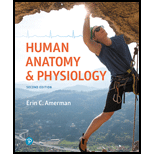
Which of the following is not one of the six basic processes carried out by the
a. Propulsion
b. Gas exchange
c. Secretion
d. Absorption
Introduction:
The digestive system in the human body helps in the breaking down of food components into smaller components after taking food into the body. It also helps in absorbing the fluid from the food to maintain electrolyte homeostasis of the body.
Answer to Problem 1CYR
Correct answer:
Gas exchange is the function of respiratory system, so not the function of digestive system.
Explanation of Solution
Justification/explanation for the correct answer:
Option (b) is gas exchange. The digestive system in the human body performs mainly six basic functions that are ingestion, secretion, digestion, propulsion, absorption, and defecation. The gas exchange is not a function of the digestive system. The gas exchange is a function of the respiratory system. Hence, option (b) is correct.
Explanation for the incorrect answers:
Option (a) is propulsion. It is one of the six basic processes carried out by the digestive system. In this process, the food and liquids are passed from one organ to another by the contractions of the smooth muscles. So, it is an incorrect option.
Option (c) is secretion. It is also one of the six basic processes of the digestive system. The gland of endocrine origin or exocrine origin secretes mucus, enzymes, acid, and hormones which helps in the digestive processes. So, it is an incorrect option.
Option (d) is absorption. Absorption is one of the six basic processes of the digestive system. The food particles are digested by mechanical and chemical means. The nutrients of the food are then moving across the wall into the blood or lymphatic vessels. So, it is an incorrect option.
Hence, options (a), (c), and (d) are incorrect.
Therefore, it can be concluded that gas exchange is not one of the six basic processes carried out by the digestive system. The six processes are ingestion, secretion, digestion, propulsion, absorption, and defecation. The gas exchange is a function of the respiratory system.
Want to see more full solutions like this?
Chapter 22 Solutions
Pearson eText Human Anatomy & Physiology -- Instant Access (Pearson+)
- Plating 50 microliters of a sample diluted by a factor of 10-6 produced 91 colonies. What was the originalcell density (CFU/ml) in the sample?arrow_forwardEvery tutor here has got this wrong, don't copy off them.arrow_forwardSuppose that the population from question #1 (data is in table below) is experiencing inbreeding depression (F=.25) (and no longer experiencing natural selection). Calculate the new expected genotype frequencies (f) in this population after one round of inbreeding. Please round to 3 decimal places. Genotype Adh Adh Number of Flies 595 Adh Adh 310 Adhs Adhs 95 Total 1000 fladh Adh- flAdn Adh fAdhs Adharrow_forward
- Which of the following best describes why it is difficult to develop antiviral drugs? Explain why. A. antiviral drugs are very difficult to develop andhave no side effects B. viruses are difficult to target because they usethe host cell’s enzymes and ribosomes tometabolize and replicate C. viruses are too small to be targeted by drugs D. viral infections usually clear up on their ownwith no problemsarrow_forwardThis question has 3 parts (A, B, & C), and is under the subject of Nutrition. Thank you!arrow_forwardThey got this question wrong the 2 previous times I uploaded it here, please make sure it's correvct this time.arrow_forward
- This question has multiple parts (A, B & C), and under the subject of Nutrition. Thank you!arrow_forwardCalculate the CFU/ml of a urine sample if 138 E. coli colonies were counted on a Nutrient Agar Plate when0.5 mls were plated on the NA plate from a 10-9 dilution tube. You must highlight and express your answerin scientific notatioarrow_forwardDon't copy off the other answer if there is anyarrow_forward
 Comprehensive Medical Assisting: Administrative a...NursingISBN:9781305964792Author:Wilburta Q. Lindh, Carol D. Tamparo, Barbara M. Dahl, Julie Morris, Cindy CorreaPublisher:Cengage Learning
Comprehensive Medical Assisting: Administrative a...NursingISBN:9781305964792Author:Wilburta Q. Lindh, Carol D. Tamparo, Barbara M. Dahl, Julie Morris, Cindy CorreaPublisher:Cengage Learning Medical Terminology for Health Professions, Spira...Health & NutritionISBN:9781305634350Author:Ann Ehrlich, Carol L. Schroeder, Laura Ehrlich, Katrina A. SchroederPublisher:Cengage Learning
Medical Terminology for Health Professions, Spira...Health & NutritionISBN:9781305634350Author:Ann Ehrlich, Carol L. Schroeder, Laura Ehrlich, Katrina A. SchroederPublisher:Cengage Learning Concepts of BiologyBiologyISBN:9781938168116Author:Samantha Fowler, Rebecca Roush, James WisePublisher:OpenStax College
Concepts of BiologyBiologyISBN:9781938168116Author:Samantha Fowler, Rebecca Roush, James WisePublisher:OpenStax College





